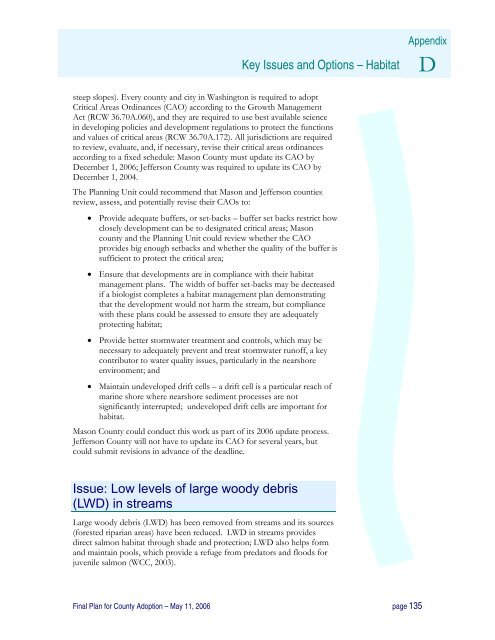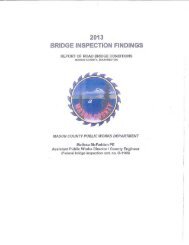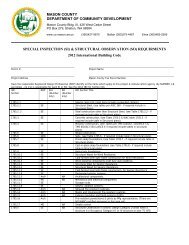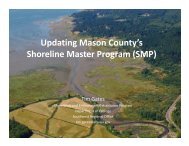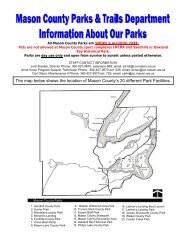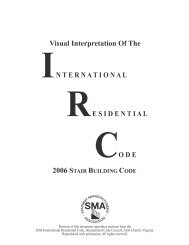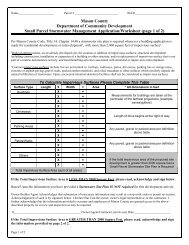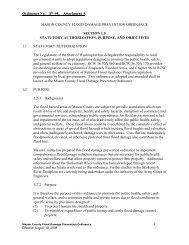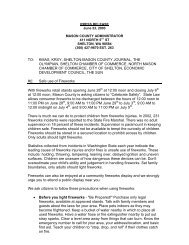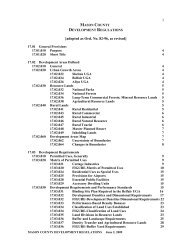Watershed Management Plan - Mason County
Watershed Management Plan - Mason County
Watershed Management Plan - Mason County
You also want an ePaper? Increase the reach of your titles
YUMPU automatically turns print PDFs into web optimized ePapers that Google loves.
Key Issues and Options – Habitat<br />
Appendix<br />
D<br />
steep slopes). Every county and city in Washington is required to adopt<br />
Critical Areas Ordinances (CAO) according to the Growth <strong>Management</strong><br />
Act (RCW 36.70A.060), and they are required to use best available science<br />
in developing policies and development regulations to protect the functions<br />
and values of critical areas (RCW 36.70A.172). All jurisdictions are required<br />
to review, evaluate, and, if necessary, revise their critical areas ordinances<br />
according to a fixed schedule: <strong>Mason</strong> <strong>County</strong> must update its CAO by<br />
December 1, 2006; Jefferson <strong>County</strong> was required to update its CAO by<br />
December 1, 2004.<br />
The <strong>Plan</strong>ning Unit could recommend that <strong>Mason</strong> and Jefferson counties<br />
review, assess, and potentially revise their CAOs to:<br />
• Provide adequate buffers, or set-backs – buffer set backs restrict how<br />
closely development can be to designated critical areas; <strong>Mason</strong><br />
county and the <strong>Plan</strong>ning Unit could review whether the CAO<br />
provides big enough setbacks and whether the quality of the buffer is<br />
sufficient to protect the critical area;<br />
• Ensure that developments are in compliance with their habitat<br />
management plans. The width of buffer set-backs may be decreased<br />
if a biologist completes a habitat management plan demonstrating<br />
that the development would not harm the stream, but compliance<br />
with these plans could be assessed to ensure they are adequately<br />
protecting habitat;<br />
• Provide better stormwater treatment and controls, which may be<br />
necessary to adequately prevent and treat stormwater runoff, a key<br />
contributor to water quality issues, particularly in the nearshore<br />
environment; and<br />
• Maintain undeveloped drift cells – a drift cell is a particular reach of<br />
marine shore where nearshore sediment processes are not<br />
significantly interrupted; undeveloped drift cells are important for<br />
habitat.<br />
<strong>Mason</strong> <strong>County</strong> could conduct this work as part of its 2006 update process.<br />
Jefferson <strong>County</strong> will not have to update its CAO for several years, but<br />
could submit revisions in advance of the deadline.<br />
Issue: Low levels of large woody debris<br />
(LWD) in streams<br />
Large woody debris (LWD) has been removed from streams and its sources<br />
(forested riparian areas) have been reduced. LWD in streams provides<br />
direct salmon habitat through shade and protection; LWD also helps form<br />
and maintain pools, which provide a refuge from predators and floods for<br />
juvenile salmon (WCC, 2003).<br />
Final <strong>Plan</strong> for <strong>County</strong> Adoption – May 11, 2006 page 135


